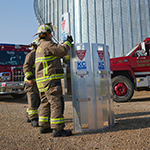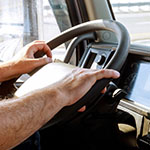Steering towards safety: Proactive measures to prevent commercial motor vehicle rollovers
Rollover accidents are a leading cause of injuries and death to commercial drivers. According to the Federal Motor Carrier Safety Administration (FMCSA), 50 percent of fatal commercial motor vehicle accidents were caused by rollovers.1 They are also a leading cost for workers compensation, auto and liability insurance. In addition, many of the vehicles involved in rollover accidents are hauling hazardous materials resulting in significant environmental clean-up cost.
To save lives and reduces losses, a comprehensive approach to reducing rollover accidents should include training, proper load securement, and adoption of technology.
Training
The cornerstone of reducing rollover accidents lies in comprehensive training. Industries with a higher propensity for rollovers, such as liquid tanker fleets, feed delivery services, and those transporting high center of gravity loads like large equipment, should prioritize rollover prevention training for all drivers. This is particularly crucial for those who may not have prior experience driving such vehicles.
This training should encompass a range of key areas:
- It should cover the securement and placement of loads, with a focus on understanding the dynamics of liquid and pelletized loads, including the effects of sloshing and surging.
- Training should also address the process of compartmentalized load offloading at various locations, a critical aspect for large fuel tankers.
- Maintaining an appropriate following distance is another vital component of the training. All drivers should be trained to maintain the commercial motor vehicle following distance standard of one second per ten feet of vehicle length. Traffic and weather conditions may require adjustment of following distance.
- Evasive or emergency driving techniques are also important training topics. For example, drivers should be taught the safest method to re-enter the highway if the right-hand tires have veered onto the shoulder of the road. They should also learn how to navigate soft shoulders on dirt or gravel roads effectively.
Maintenance
Ensuring the safe operation of a commercial motor vehicle is paramount, and this is particularly true when it comes to preventing rollovers. A thorough pre-trip inspection can help identify any potential issues.
Four key areas warrant special attention:
- Steering must be responsive. If it’s too “loose,” it could lead to oversteering, which can potentially trigger a rollover.
- Tires should be properly inflated. Under-inflated tires on one side can significantly alter the vehicle’s center of gravity, leading the driver to make incorrect adjustments. Worn or uneven tires can cause a blowout, which might force the driver into an emergency or evasive maneuver.
- Suspension systems with faults can also shift the vehicle’s center of gravity, resulting in instability.
- Brakes are crucial. It’s important to ensure that all brakes are correctly adjusted and functioning properly. If the trailer is equipped with anti-lock brakes, their operation should be verified.
Proper load securement
In transportation, specific combinations require load securement. [link to load securement]. It’s crucial that drivers receive comprehensive training on the correct procedures for preventing load displacement. This instruction should encompass both flatbed and trailer, as shifting loads can significantly alter the vehicle’s center of gravity.
Companies bear the responsibility of providing an ample supply of securement devices for their drivers. It’s equally important to ensure that drivers are well-versed in the regulations governing the type and size of these securement systems.
By implementing regular inspections and promptly replacing worn-out securement devices, companies can significantly decrease the risk of load loss. This proactive approach not only enhances safety but also contributes to the efficiency and reliability of the transportation process.
Speed management
Understanding and mastering speed control is crucial for drivers. Many tend to depend solely on the throttle and brake for managing speed, which is a common misconception. This over-reliance can lead to improper braking and steering, potentially resulting in dangerous rollovers. It’s essential for drivers to broaden their knowledge and skills by learning to utilize engine retarders, transmission, and even the force of gravity to maintain their vehicle’s speed effectively. This comprehensive approach to speed control not only enhances safety but also improves the overall driving experience.
Technology
Advancements in technology have paved the way for effective measures to prevent rollover accidents. While technology alone may not eliminate all rollovers, it can significantly decrease their occurrence when combined with other safety practices.
One such innovation is the Electronic Stability Control (ESC), which is now a standard feature in all new trucks. If you’re considering purchasing a used truck, it’s advisable to look for those equipped with ESC.
Another effective tool is telematics which can be used to monitor driver behavior. This technology not only helps in reducing rollovers but also ensures that drivers adhere to your company’s driving policies.
In addition, cameras can offer valuable insights into potential driver distractions, thereby promoting a more attentive driving environment.
While preventing rollover accidents requires effort, the benefits far outweigh the investment. Considering both the financial and human aspects, accident prevention yields a high return on investment. It’s an endeavor that is undoubtedly worth pursuing.
References
[1] Fatality Facts 2022: Large Trucks, Insurance Institute for Highway Safety (IIHS), June 2024.
Cargo tank truck rollover prevention, Federal Motor Carrier Safety Administration (FMCSA), February 2023.

 >
>

 >
>
 >
>